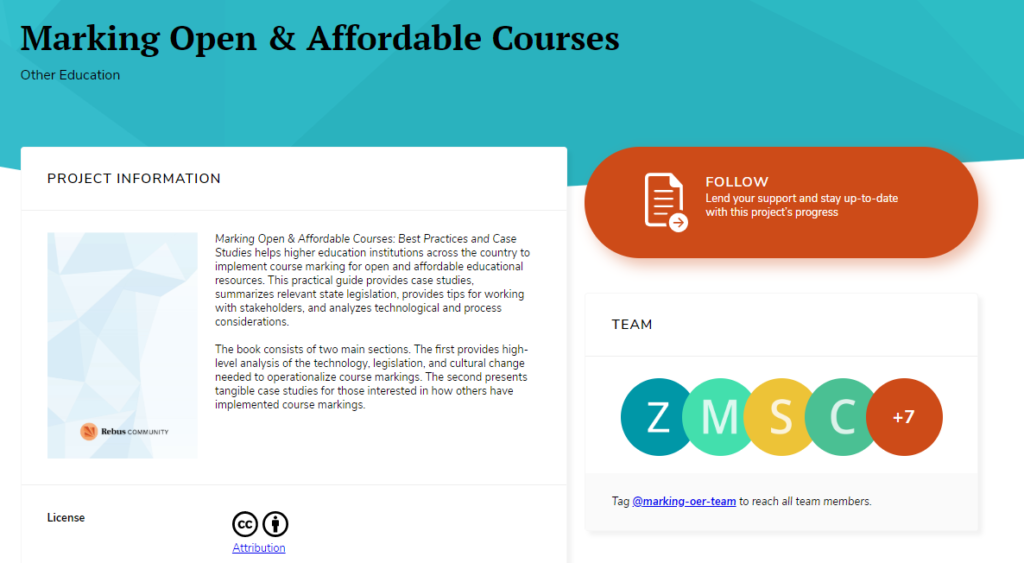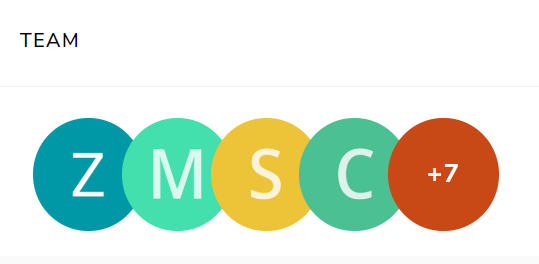This is the eighth in a series of reports filed by Donna Langille, a practicum student who joined us for the spring of 2019. We’ll be releasing each chapter as a weekly blog post. Find the complete text at Rebus Community Reports.

Making Marking
The OER about OER from Michelle Reed, Sarah Hare, and Jessica Kirschner
When educators make the decision to transition to open educational resources (OER) instead of using high-priced commercial materials, the benefits to students are immediate. Cost and barriers to access are reduced, learning is streamlined. Yet on the administrative side of things, additional work is incurred, specifically when it comes to making it known which courses use open and affordable educational materials. “Marking” a course’s resources as open or affordable means tagging and displaying this information, online and in print materials, so that students can easily understand the resource costs associated with the course.
Fortunately for all those going through this process, the open-access book Marking Open & Affordable Courses: Best Practices and Case Studies provides many examples and suggestions for doing so. And the way that the project came about and has evolved is also an example of the responsiveness and flexibility of open publishing.
In 2017, the Texas legislature enacted law SB810, a component of which requires universities to indicate on course registration systems which courses use OER. The law is intended to help students make decisions about registering for courses by having clear information about the cost of required materials. However, because the timeline for complying with the new law was brief, numerous institutions of higher education quickly had to learn how to implement the necessary changes.
As Director of Open Educational Resources at the University of Texas Arlington (UTA) Libraries, Michelle Reed knew the law would have significant implications for both librarians and educators, and assumed responsibility for leading UTA’s course marking implementation. This would mean working with campus partners to ensure compliance with the law, before the state’s implementation deadline. At the time, Michelle was enrolled in the SPARC Open Education Leadership Program, so she decided to focus her capstone project on the implementation process. That project, the Texas Toolkit for OER Course Markings, has now become an open access book project called Marking Open & Affordable Courses: Best Practices and Case Studies. The original Toolkit was structured as a LibGuide (a tool for organizing and showcasing library resources on a given subject); the new OER will be more robust, including practical advice and individually written case studies.
Marking Open & Affordable Courses is therefore an OER about OER, and differs from other projects within the Rebus Community because of its hybrid nature and the audiences at which it is directed. The book is still in the drafting phase and comprises multiple case studies as well as six topical sections. These cover legislation, institutional policy, stakeholders, platforms and processes, branding, communication, and impact. For those looking to mark open and affordable courses at their own institutions, the book is both a practical guide and an overview of the bigger picture.
Transforming the original Texas Toolkit into its new incarnation has been possible through the help that Michelle receives from co-editors Sarah Hare and Jessica Kirschner. Sarah, a scholarly communication librarian at Indiana University, and Jessica an OER librarian at Virginia Commonwealth University, originally served as peer reviewers for the Texas Toolkit. When Michelle wanted to expand it into a book, the two agreed to co-lead the project with her.
As the new project unfurls, the three women work to remain flexible in their designated and more informal roles, dividing the editorial review process and other tasks. Michelle serves as project manager and all three share the title (and responsibilities) of co-editor. Five other team members act as section leaders. These people serve as point people for the three to four contributing authors per section. Each section leader works with their assigned co-editor, who helps them meet deadlines and respond to comments. As the book develops, the team will bring on more collaborators to help with peer review and copyediting. They currently include librarians, instructors, and even a bookstore manager, all of whom meet regularly to discuss progress and challenges.
For Sarah, this project is a valuable “meta-experiment” in walking her talk as a librarian and openness advocate. It is an opportunity to practice what she recommends to instructors: “Work with Rebus Community, use Pressbooks, and deploy existing OER infrastructures.”

Participating in this experiment has been both exciting and invigorating, as well as an important occasion to understand first-hand the challenges of making OER. There are some sections of the book for which existing literature is minimal or non-existent. In these cases, the co-editors have to guide their authors through creating new content, rather than adapting or expanding on previously written material. Sometimes that means drawing on case studies for details, sometimes it means looking to informal communications with colleagues, such as conference presentations. Seeking out information that exists outside the conventional academic record has revealed insights that might otherwise go undocumented. It also means a certain amount of extra work for both the co-editors and authors.
To make sure that the book as a whole remains coherent, the co-editors encouraged all the contributors to read both the case studies and the other topical sections of the book. This has given them all a sense of what they are collectively trying to accomplish. Rather than the somewhat anonymous and isolated experience of authoring a chapter for a conventionally published volume, the making of Marking has been more cross-communicative. Case studies and topical content ‘speak to each other’, just as the various contributors have.
For her part, Michelle has learned just how much labour is involved in publishing open textbooks. It’s a good reminder, especially when it comes to reaching out to the university community, to convince people to become OER contributors. The need to seek out shared values and a willingness to “embrace imperfection” are other key lessons. Despite many authors’ tendencies to be perfectionists, openly published resources provide a safety net: you can always go back to the text, revise content, and fix errors.
Michelle, Sarah, and Jessica have already made many marks with Marking Open & Affordable Courses—on themselves, their contributors and communities, and within the world of OER more broadly. As this new book finds its way into the hands of other OER advocates (in Texas and everywhere), that impact will expand and grow. And if the local or national legislation changes course marking requirements again, no problem. They’ll just revise and re-release the book, openly.

Images from the new Rebus Community project homepage have been included in this post. To view the complete project homepage for Marking Open & Affordable Courses visit Rebus.Community. Create a project homepage for your open textbook in development by logging on to Rebus.Community and clicking “Create a Project.”
